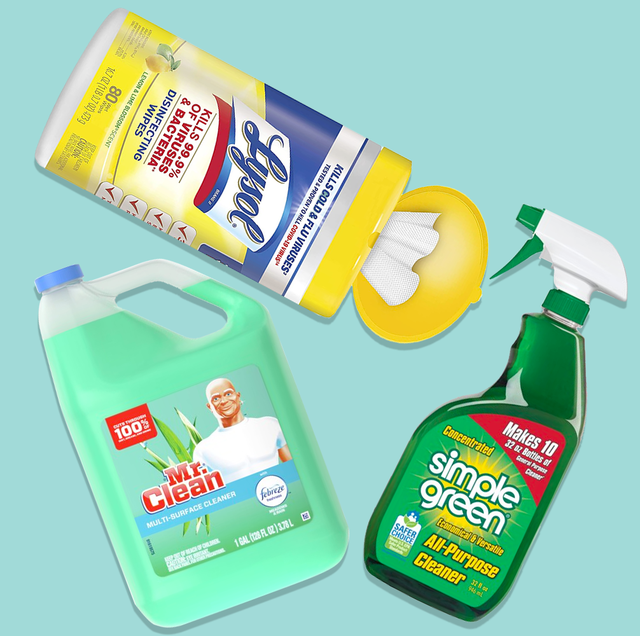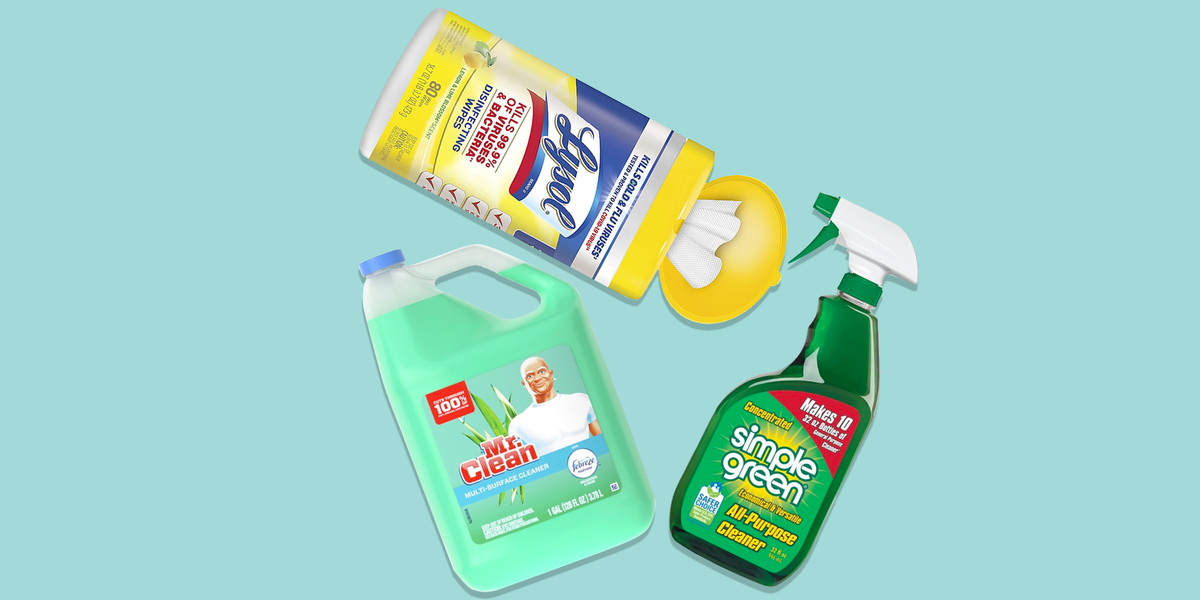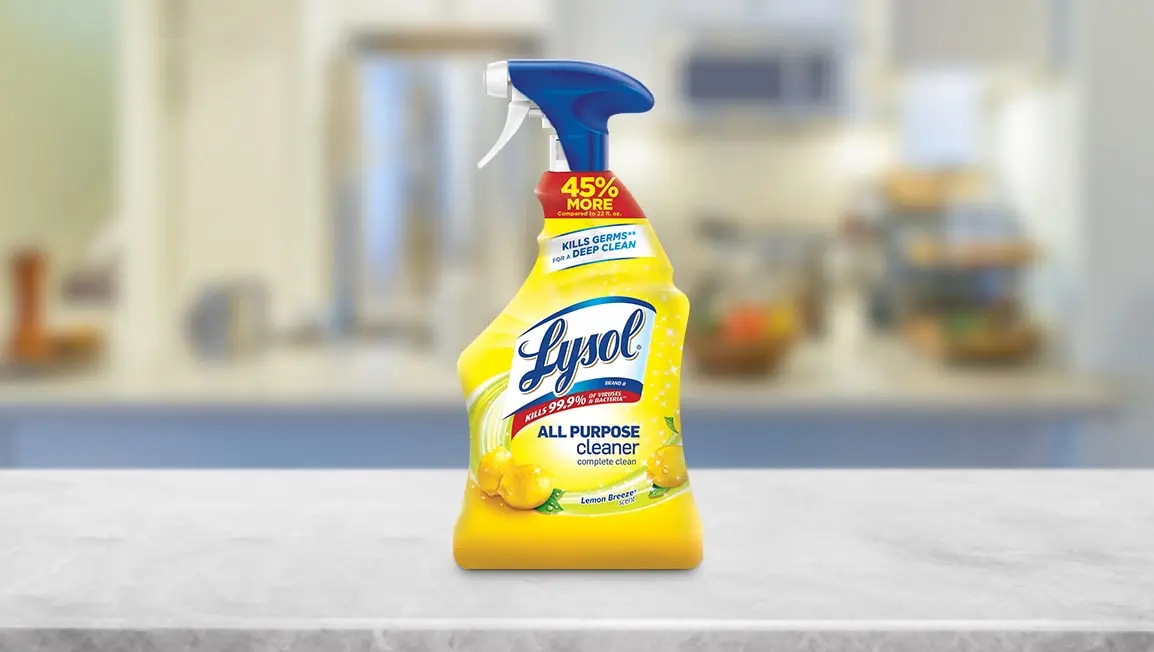Lysol All Purpose Cleaner typically does not stain walls. It’s formulated to be safe on painted surfaces when used as directed.
Ensuring a clean and hygienic environment is a priority for homeowners, and Lysol All Purpose Cleaner is a popular choice for tackling a wide range of cleaning tasks. Its versatility and disinfecting properties make it an essential product in the cleaning arsenal of many households.
As a go-to solution for dirt, grime, and bacteria, people often wonder about its safety on various surfaces, especially painted walls. The concern about staining is valid, given that some cleaning agents can be harsh. Yet, Lysol’s clear, non-bleach formula is designed to perform effectively without leaving behind any unsightly stains, ensuring that cleaning efforts enhance the home’s appearance and health without any unintended damage.

Credit: www.goodhousekeeping.com
Introduction To Household Cleaners And Wall Care
Keeping a home spick and span is no easy feat. The walls around you tell a tale of bustling household activity, often collecting dust, grime, and occasional stains. While reaching for that bottle of cleaner might be a reflex, it’s crucial to understand how different household cleaners can interact with wall surfaces. Whether it’s tackling splashes from an enthusiastic cooking session or crayon masterpieces from a little artist, choosing the right cleaner can make a difference between spotless walls and unfortunate stains.
Overview Of Common Household Cleaners
From sprays to wipes, the variety of cleaners in the household aisle can be overwhelming. Familiar names like Lysol, Clorox, and Mr. Clean might jump out. Each product comes with its own strengths and is designed for specific tasks. Some are gentle and perfect for daily touch-ups while others pack a stronger punch for stubborn grime.
- Multi-surface cleaners – Safe for various surfaces with mild ingredients.
- Disinfectants – Kill germs but might be harsh on some surfaces.
- Specialty cleaners – Formulated for glass, wood, or metal.
The Importance Of Choosing The Right Cleaner For Different Surfaces
Walls are not just another surface; they define your home’s character. It’s vital to select the correct cleaner to avoid damage. A cleaner like Lysol All Purpose Cleaner is typically safe on painted walls but always do a spot test first. Certain surfaces require specific care—using a harsh cleaner on delicate wallpaper or a painted mural could be a recipe for disaster. Consult your cleaner’s label and match it to the wall’s material for the best outcome.
| Surface Type | Suggested Cleaner Type |
|---|---|
| Painted Walls | Mild Detergent or Multi-surface Cleaner |
| Wallpaper | Soap and Water or Wallpaper Cleaner |
| Wood Panels | Specially Formulated Wood Cleaner |
Remember, before applying any cleaner liberally, a small, inconspicuous test patch can prevent potential stains or discolorations. Gentle wiping motions rather than vigorous scrubbing will keep your walls in pristine condition for years to come.

Credit: www.goodhousekeeping.com
Understanding Lysol All Purpose Cleaner
Cleaning is a big part of daily life. Many people choose Lysol All Purpose Cleaner for a shiny, germ-free home. Will this cleaner leave stains on your walls? Let’s dive into what makes up this cleaner and where it’s safe to use.
Composition And Properties Of Lysol Cleaner
Lysol Cleaner has a mix of ingredients designed to tackle dirt and germs:
- Disinfectants: Kills germs on surfaces.
- Detergents: Breaks up grease and grime.
- Water: The main base of the solution.
These parts work together for a powerful clean without harsh chemicals.
| Ingredient | Purpose |
|---|---|
| Alkyl Dimethyl Benzyl Ammonium Chlorides | Disinfects |
| Sodium Lauryl Sulfate | Cleaning agent |
Advertised Uses And Target Surfaces For Lysol
The cleaner is perfect for many spots inside your home:
- Countertops.
- Kitchen sinks.
- Appliance exteriors.
Use Lysol on walls with caution. Porous surfaces may not react well to the cleaner.
An easy test can save your walls:
- Find a hidden part of the wall.
- Apply a small amount.
- Wait and see.
If no stains show, you’re good to go. For best results, read the label before use.
Potential Risks Of Using Lysol On Walls
Cleaning walls can be tricky, especially when using products like Lysol All Purpose Cleaner. Although effective at killing germs, it’s important to know Lysol’s impact on your wall surfaces. This includes understanding how this potent cleaner can interact with various paints and wallpapers.
Chemical Interaction With Paint And Wallpaper
Lysol’s formula includes chemicals that may not always be friendly to the delicate surfaces on your walls. Different types of paint or wallpaper respond uniquely to cleaning agents. Here’s what you should keep in mind:
- Glossy and semi-gloss paints tend to be more durable and can usually withstand Lysol without staining.
- Matte finishes and wallpapers might not be as forgiving and can absorb cleaning solutions, leading to discoloration.
- Some paints may fade or bleach when treated with the ingredients in Lysol, specifically ammonia or alcohol-based substances.
Precautions To Avoid Damage While Cleaning Walls
To keep walls clean and damage-free while using Lysol, follow these straightforward steps:
- Test a small, hidden area first before applying Lysol over a large surface.
- Dilute the cleaner with water, particularly for surfaces prone to damage.
- Use a soft cloth or sponge to gently wipe, avoiding abrasive tools like steel wool.
- Never spray Lysol directly onto the wall. Instead, apply it to the cleaning cloth.
- If you’re unsure, consult the paint or wallpaper manufacturer for product-specific recommendations.
By taking these precautions, your walls will not only stay spotless, but safe from unwanted stains or damage due to cleaning products like Lysol.
Case Studies: Lysol And Wall Stains
Does Lysol leave marks on walls? Lysol All Purpose Cleaner is a staple in many households. It promises a germ-free environment. But, a pressing concern for many is whether it stains walls. Let’s explore what people and studies tell us.
Anecdotal Evidences Of Wall Stains After Using Lysol
Many users share their stories about using Lysol on walls. Some see no harm, while others report discoloration. Here are common observations:
- Paint Type Matters: Glossy paints are less prone to stains.
- Color is Key: Lighter walls might show no stains, darker tones could change.
- Test First: It’s best to try on a small, hidden wall spot.
Scientific Findings On Lysol’s Effect On Wall Surfaces
Studies dig deeper into Lysol’s impact on wall surfaces. Results help us understand its effects:
| Surface Type | Reaction | Safety |
|---|---|---|
| Non-Porous | No reaction | Usually safe |
| Porous | May stain | Care needed |
| Painted | Varies by paint | Patch test first |
Safe Cleaning Practices With Lysol
Cleaning walls can sometimes cause stress. Is it safe to use Lysol All Purpose Cleaner? This popular cleaner is a go-to for tough messes. Yet, no one wants stained or damaged walls. It’s time to learn safe cleaning practices with Lysol, so you can keep your space sparkling without worry.
Best Practices For Using Lysol Without Damaging Walls
Protecting your wall’s finish is key while using Lysol. Stay safe and effective with these steps:
- Test in a small area. Apply Lysol to a hidden part to check for colorfastness.
- Use a soft cloth. Rough materials could scratch paint or wallpaper.
- Don’t overspray. Less is more. A gentle mist is the path to a clean wall.
- Wipe gently. Preserve the surface by avoiding hard scrubbing.
- Follow the label. Lysol’s instructions are the roadmap to safe use.
Alternative Cleaning Solutions For Sensitive Wall Surfaces
Some walls need extra care. If Lysol feels too harsh, consider these gentle alternatives:
| Alternative | Use For | Application |
|---|---|---|
| Vinegar and Water | Mild cleaning | Equal parts solution; apply with a damp cloth. |
| Baking Soda | Spot treatment | Create a paste; dab on gently, then rinse. |
| Mild Dish Soap | General washing | Few drops in water; wipe with a non-abrasive sponge. |
Some walls are more sensitive. Always choose a milder option when Lysol feels risky. Remember to wipe surfaces softly and dry them promptly to prevent watermarks.
Healthy walls mean a happy home. With proper practices and alternatives, you can maintain both easily.
Expert Advice On Wall Cleaning And Maintenance
Keeping walls clean and stain-free is a pillar of pristine home upkeep. Over time, walls can accumulate dirt, grime, and stains. It’s important to know the right methods and products, like Lysol All Purpose Cleaner, for effective wall maintenance. This section dives into professional insights on wall cleaning and preventive care.
Recommendations From Professional Cleaners
Professional cleaners favor specific strategies for wall cleaning. These experts suggest a gentle yet effective approach. Here’s what they recommend:
- Test Cleaners: Always spot test Lysol on hidden areas.
- Gentle Application: Use a soft cloth or sponge for the application.
- Avoid Harsh Scrubbing: Scrubbing too hard can damage paint.
- Follow Instructions: Adhere to the product’s usage directions.
Lysol All Purpose Cleaner is generally safe for walls but proceed with caution. Certain finishes may not be compatible, and spot testing is crucial to prevent unwanted outcomes.
Tips For Regular Wall Maintenance To Prevent Stains
Regular upkeep reduces the chances of stubborn stains. Here are quick tips to keep your walls looking their best:
- Dust walls with a microfiber cloth periodically.
- Clean spills and marks immediately to prevent setting.
- Use a mild detergent solution for routine cleaning.
- Avoid excessive moisture that can seep into walls.
By following these steps, walls remain in top condition. Emergency cleaning is less likely, preserving the integrity and appearance of your walls for years to come.
Common Mistakes To Avoid When Cleaning Walls
Common Mistakes to Avoid When Cleaning Walls can lead to unwelcome surprises. A clean wall enhances a room’s beauty. Yet, using products like Lysol All-Purpose Cleaner incorrectly may do more harm than good. Careful wall cleaning ensures integrity and color preservation. Let’s delve into the ways to maintain spotless walls without damage.
Overlooking The Need For Spot Testing
Before applying any cleaner, one critical step often gets ignored: spot testing. It ensures the chosen cleaner won’t harm your walls. Apply a small amount in an inconspicuous area. Check the result after a few minutes. This precaution safeguards against unwanted stains or discoloration. Always verify compatibility with your wall paint or wallpaper.
Excessive Use Of Cleaners And Potential Long-term Effects
Using Lysol All-Purpose Cleaner sparingly is key. Overuse can wreak havoc on wall surfaces. Excessive cleaner application often leads to wall damage. It strips away paint or leaves residue. The ill effects might not show immediately but can emerge over time. Striking a balance ensures a clean surface without the negative outcomes. Below, learn the appropriate cleaner usage:
- Dilute the cleaner as suggested by the label.
- Spray lightly onto a clean cloth instead of directly on the wall.
- Wipe in a gentle, circular motion to avoid scrubbing off paint.
- After cleaning, use a dry cloth to remove any moisture.
Conclusion: Balancing Cleanliness And Preservation
Cleanliness and preservation must go hand in hand when maintaining the walls in our spaces. Using Lysol All Purpose Cleaner can leave us questioning its impact on our vibrant walls. The key lies in striking that perfect balance to ensure our walls stay both clean and visually appealing.
Summarizing The Safe Use Of Lysol On Walls
To keep walls unspoiled, we need to employ Lysol safely. Here’s how:
- Test in an inconspicuous area first.
- Apply with a gentle touch.
- Dilute if necessary, following product guidelines.
- Avoid oversaturation to prevent drips.
- Wipe with a soft, damp cloth after application.
These steps will ensure your walls are clean without damage.
Final Thoughts On Protecting Wall Aesthetics During Cleaning
Preserving the beauty of our walls is as important as cleaning them. While Lysol is effective, its use must be mindful to avoid stains.
- Choose the right cleaner based on wall paint and material.
- Practice regular dusting to minimize the need for wet cleaning.
- Address stains immediately to reduce the need for harsh chemicals.
By following these steps, we ensure that our walls stay spotless and splendid.

Credit: www.walmart.com
Frequently Asked Questions On Will Lysol All Purpose Cleaner Stain Walls
Is Lysol All Purpose Cleaner Safe On Walls?
Yes, Lysol All Purpose Cleaner is generally safe for use on walls. Always test a small inconspicuous area first and follow the instructions on the label.
Does Lysol Leave Stains?
Lysol generally does not stain fabrics and surfaces, but it’s essential to spot test in an inconspicuous area before use. Always follow label instructions to avoid potential discoloration.
Can You Use Lysol All Purpose Cleaner In The Bathroom?
Yes, Lysol all-purpose cleaner is suitable for cleaning various surfaces in the bathroom, including tiles, bathtubs, and sinks.
Does Lysol All Purpose Cleaner Have Bleach?
No, standard Lysol all-purpose cleaner does not contain bleach. It cleans and disinfects surfaces without the use of harsh chemicals like bleach.
Conclusion
Wrapping up our discussion on Lysol’s effect on walls, it’s clear that careful application is key. Stick to manufacturer guidelines to avoid unwanted stains. Remember, maintaining the pristine condition of your painted surfaces is paramount. A spot test and prompt wiping can keep your home’s walls looking spotless and vibrant.
Choose Lysol with confidence for a clean, stain-free environment.
